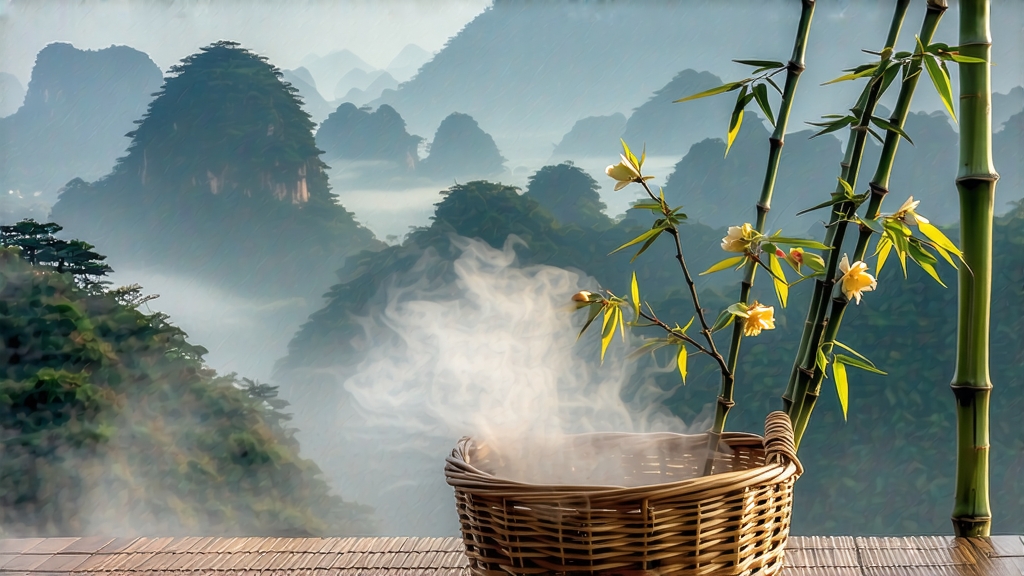
Tucked high on the mist-locked shoulders of Mt. Mengding in Sichuan Province, Mengding Huangya—literally “Yellow Bud of Mengding”—has been whispering its gentle secrets to Chinese emperors, poets and monks for more than twelve centuries. Today, when even veteran tea traders rush past it in favor of better-known greens or puerhs, this micro-lot yellow tea remains one of the least exported, most misunderstood styles in the entire Chinese lexicon. Yet one sip of its silk-bright liquor explains why Tang-dynasty court diarists recorded it as “the first tea of spring, presented to the Son of Heaven before heaven itself fully wakes.”
History: From Imperial Tribute to Vanishing Craft
Mengding Mountain, often shrouded in cloud at 1 450 m, is the mythical birthplace of cultivated tea. According to legend, the Daoist sage Wu Lizhen planted seven tea bushes on the summit around 53 BCE; those mother bushes, now protected by a shrine, are still venerated each Qingming festival. By the Tang dynasty (618-907) the area’s earliest spring buds—so pale they looked almost albino—were steamed, pressed into cakes and dispatched along the Silk Road to Chang’an. When cake tea fell from fashion during the Song, local monks switched to loose-leaf processing and accidentally discovered the “smothering” step that turns green into yellow. The Ming emperor Hongwu (r. 1368-1398) formally listed Mengding Huangya as one of the eighteen imperial tribute teas, a status it held for nearly three hundred years. After the fall of the Qing, demand collapsed; by the 1980s fewer than a dozen elderly villagers still remembered the full protocol. A state-sponsored revival in 1987 rescued the cultivar from extinction, yet annual production remains under three metric tons, most of it allocated to government banquets and discreet collectors.
Terroir & Cultivar: Where Clouds Marry Stone
Mt. Mengding enjoys a classic Sichuan climate—cool, humid and perennially overcast. Frequent “dao yu” (knife rain) showers last only minutes, leaving the granite soil well-drained yet water-retentive. The fog refracts sunlight into soft, diffuse spectra that slow photosynthesis, forcing the tea bush to synthesize more theanine and fewer bitter catechins. Local seed-selected gardens are dominated by the small-leaf “Mengding #9” cultivar, whose buds are unusually high in soluble sugars and show a faint ivory cast even on the bush. Because the mountain is a protected scenic zone, no agro-chemicals are permitted; fertility comes from mulched bamboo leaves and composted wildflowers.
Plucking Calendar: One Dawn, One Leaf
The picking window is brutally short: from the first flush around March 20 until Qingming (April 4 or 5). Only the “flag-bud” set—an unopened apical bud flanked by two cat’s-eye leaves—is taken. Experienced pluckers finish before 9 a.m. while dew still pearls the shoots; any later and the sun wilts the cells, complicating the yellowing step. A master can harvest just 600 g of fresh leaf in a day; five kilos are required to yield one kilo of finished tea.
Craft: The Art of Slow Suffocation
Yellow tea’s defining moment is “men huang” (smothering or sealing yellow), a controlled post-fixation re-humidification that nudges the leaf into a non-enzymatic oxidation so subtle it stops just short of becoming white tea. Mengding Huangya is processed entirely by hand in a three-room mountain hut that has changed little since the Qing.
- Sha Qing (Kill-Green) – Buds are tossed into a wok heated to 140 °C for 90 seconds. The goal is to destroy leaf enzymes while preserving a 7 % moisture core.
- Re Ying (First Rolling) – Immediately after kill-green, the scorching leaf is rolled on a bamboo tray with the heel of the palm for four minutes; the pressure is so light that no juice exudes, but the cell walls micro-fracture, preparing the leaf for yellowing.
- Men Huang (Smothering) – The still-warm leaf is piled 4 cm deep inside a cedar box lined with wet linen. The lid is closed and weighted with river stones. Over the next six to eight hours the core temperature